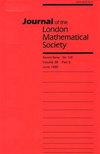The genus 1 bridge number of satellite knots
IF 1.2
2区 数学
Q1 MATHEMATICS
Journal of the London Mathematical Society-Second Series
Pub Date : 2025-08-11
DOI:10.1112/jlms.70260
引用次数: 0
Abstract
Let be a satellite knot, link, or spatial graph in a 3-manifold that is either or a lens space. Let and denote genus 0 and genus 1 bridge number, respectively. Suppose that has a companion knot (necessarily not the unknot) and wrapping number with respect to . When is not a torus knot, we show that . There are previously known counterexamples if is a torus knot. Along the way, we generalize and give a new proof of Schubert's result that . We also prove versions of the theorem applicable to when is a “lensed satellite” and when there is a torus separating components of .


属1桥数卫星节
设T $T$为3流形M $M$中的卫星结、链路或空间图,该3流形M 是s3 $S^3$或透镜空间。设b0 $\mathfrak {b}_0$和b1 $\mathfrak {b}_1$分别表示0和1属桥号。假设T $T$有一个伴结K $K$(不一定是解结)和相对于K $K$的包裹数ω $\omega$。当K $K$不是环面结时,我们显示b1 (T)小于ω b1 (K) $\mathfrak {b}_1(T)\geqslant \omega \mathfrak {b}_1(K)$。如果K $K$是环面结,有一些已知的反例。一路走来,我们推广并给出舒伯特结果的新证明b 0 (T)小于ω b 0 (K)$\mathfrak {b}_0(T) \geqslant \omega \mathfrak {b}_0(K)$。我们还证明了当T $T$是一个“透镜卫星”以及当有一个环面分离T $T$的组件时适用的定理版本。
本文章由计算机程序翻译,如有差异,请以英文原文为准。
求助全文
约1分钟内获得全文
求助全文
来源期刊
CiteScore
1.90
自引率
0.00%
发文量
186
审稿时长
6-12 weeks
期刊介绍:
The Journal of the London Mathematical Society has been publishing leading research in a broad range of mathematical subject areas since 1926. The Journal welcomes papers on subjects of general interest that represent a significant advance in mathematical knowledge, as well as submissions that are deemed to stimulate new interest and research activity.

 求助内容:
求助内容: 应助结果提醒方式:
应助结果提醒方式:


